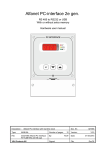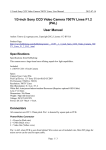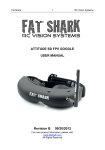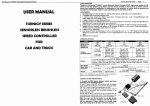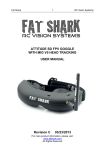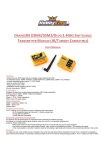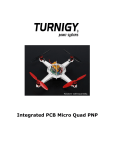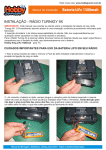Download Turnigy 2S-3S LiPO Battery Charger / Balancer
Transcript
Turnigy 2S/3S Lithium Polymer Battery Charger User Manual 1. DESCRIPTION 1.1 Before using the Turnigy 2S/3S Lithium Polymer (LiPO, Li-Po) battery charger you must read this manual. It is important to understand its operation and all safety steps before using it. 2.0 FEATURES 2.1 The charger’s power input requires 11V to 14V DC power. Higher or reversed voltages will cause permanent damage and will void the warranty. 2.2 There are two LED status lights. The red light indicates that power is connected to the charger. The green light means that charging is in progress. The green light goes out when charging is complete. 3.0 ELECTRICAL SPECIFICATIONS 3.1 Input Voltage: 11V-14VDC at l.2A. A voltage regulated 11V-l4V DC supply may be used. Or a 12VDC automotive battery (rated at 15 AH or higher). 3.2 Output voltage: 2S operation: 8.4 VDC 3S operation: 12.6 VDC 3.3 Output Current: 800 mA typical 3.4 Output Balance Accuracy: 20mV typical 3.5 The red alligator lead is the Positive power input, and the Black alligator is negative input. Do NOT connect the power leads backwards (reverse voltage). This will damage the charger and void the warranty. 4.0 CHARGING PROTECTION 4.1 Microprocessor based real-time monitoring techniques use precise calculations to ensure a full battery charge indication. It helps to ensures safe and reliable recharge control, which extends battery life. 4.2 The fully charged battery voltage difference, between the individual cells, is typically less than 20mV. Charging cut-off voltage is between 4.18V to 4.20V. 4.3 The charger automatically detects if the battery pack is two (2S) or three (3S) series-connected cells. There is a cable port connection dedicated for 2S packs and another one for 3S packs. Do not charge more than one pack at a time. DO NOT install two packs! Copyright 2009 Page 1 Feb-15-2009 5.0 ATTENTION 5.1 Never leave the charger unattended. If you will be away from the charger then do leave it connected it to the battery. EVER. 5.2 Charge all batteries on concrete, at least 10 feet (3 meters) away from combustible materials. 5.3 Do not use if flammable liquids are in the area. 5.4 Use this charger only with compatible Lithium Polymer battery packs. No other battery chemistry can be used. 5.5 Do not charge batteries that are hot. Allow them to cool first. 5.6 Do not charge any battery that appears to be swollen or damaged in any way. 5.7 Do not disassemble the charger in any way. This is dangerous and will void the warranty. 5.8 Keep the charger away from children and animals. 5.9 Do not connect more than one battery pack a time. Please see the additional information on the next page. Copyright 2009 Page 2 Feb-15-2009 Lithium Polymer (LiPo) BATTERY SAFETY INFORMATION If not charged or used correctly, Lithium Polymer batteries may ignite without warning and cause serious injury and property damage. If you are unable to follow the safety recommendations then do not use them. Do not leave a LiPo battery unattended during charging or discharging. Always store LiPo batteries in a secure location away from children and animals. NEVER charge Lithium Polymer batteries with a charger designed for NiCd, NiMH, or any other type of battery chemistry. Do not allow LiPo cells to overheat at any time. Cells which reach greater than 140E Fahrenheit (60EC) will usually become damaged and could catch fire. Do not charge LiPo cells on or near combustible materials including paper, plastic, carpets, vinyl, leather, or wood. Do not charge inside an automobile. Do not forcefully discharge, doing so will damage the pack. Never exceed the charge or discharge current rating. Do not expose LiPo cells to water or moisture at any time. Do not store or use LiPo batteries near an open flame or heater. Do not assemble LiPo cells or pre-assembled packs together with other LiPo cells or packs. Never use a LiPO battery that may have been subjected to damage or harsh handling. Carefully inspect the battery and connectors for even the smallest damage. CAUTION: cells may be hot! Do not allow the electrolyte to get into eyes or on skin. Wash affected areas immediately if they come into contact with electrolyte. Do not alter or modify connectors or wires of a Lithium battery pack. Copyright 2009 Page 3 Feb-15-2009




